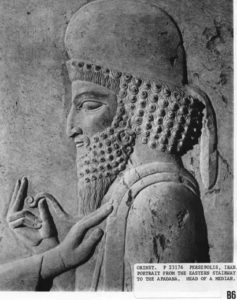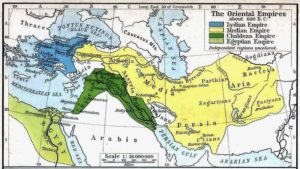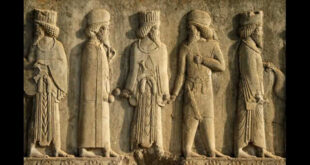
Apart from a few personal names, the language of the Medes is almost entirely unknown. It was most likely similar to the Avestan and Scythian languages.
Herodotus lists the names of six Mede tribes or castes. Some of these are similar to tribal names of the Scythians, suggesting a definitive link between these two groups.
- The Busae group is thought to derive from the Persian term buza meaning indigenous (i.e. not Iranian). Whether this was based on an originally Iranian term, or their own name, is unknown.
- The second group is called the Paraetaceni, or Parae-tak-(eni) in Persian, and denotes nomadic inhabitants of the mountains of Paraetacene. This name recalls the Scythian Para-la-ti, the people of Kolaxis, believed to represent the common people in general, but whom Herodotus calls the “Royal Scythians”.
- The third group is called Strukhat.
- The fourth group is the Arizanti, whose name is derived from the words Arya (noble), and Zantu (tribe, clan).
- The fifth group were the Budii, found also among the Black Sea Scythians as Budi-ni. Buddha was of the tribe Budha, the Saka (eastern Scythian) form of the name.
- The sixth tribe were the Magi…They were a hereditary caste of priests of the Zurvanism religion that evolved out of Zoroastrianism. The name Magi implies a link with the Sumerians, who called their language Emegir, over time becoming simplified to Magi. Hungarian tradition also traces pre-European Magyar (Hungarian) ancestry back to the Magi. In time, the Sumerian-influenced religion of the Magi was suppressed in favour of a more purely Iranian form of Zoroastrianism, itself evolved from its somewhat dualist beginnings into the monotheistic faith that it is today (also known as Parsi-ism).
The origin and history of the Medes is quite obscure, as we possess almost no contemporary information, and not a single monument or inscription from Media itself. The story that Ctesias gave (a list of nine kings, beginning with Arbaces, who is said to have destroyed Nineveh about 880 BC, preserved in Diod. ii. 32 sqq. and copied by many later authors) has no historical value whatever; though some of his names may be derived from local traditions.
Josephus relates the Medes (OT Heb. Madai) to the biblical character, Madai, son of Japheth. “Now as to Javan and Madai, the sons of Japhet; from Madai came the Madeans, who are called Medes, by the Greeks” Antiquities of the Jews, I:6.
Other ancient historians including Strabo, Ptolemy, Herodotus, Polybius, and Pliny, mention names such as Mantiane, Martiane, Matiane, Matiene, to designate the northern part of Media.
We can see how the Iranian element gradually became dominant; princes with Iranian names occasionally occur as rulers of other tribes. But the Gelae, Tapuri, Cadusii, Amardi, Utii and other tribes in northern Media and on the shores of the Caspian may not have been Iranian stock. Polybius (V. 44, 9), Strabo (xi. 507, 508, 514), and Pliny (vi. 46), considered the Anariaci to be among these tribes; but their name, meaning the “not-Arians”, is probably a comprehensive designation for a number of smaller indigenous tribes.
The Medes, people of the Mada, (the Greek form “Μηδοί” is Ionian for Madoi), appear in history first in 836 BC. Earliest records show that Assyrian conqueror Shalmaneser II received tribute from the “Amadai” in connection with wars against the tribes of the Zagros. His successors undertook many expeditions against the Medes (Madai).
At this early stage, the Medes were usually mentioned together with another steppe tribe, the Scythians, who seem to have been the dominant group. They were divided into many districts and towns, under petty local chieftains; from the names in the Assyrian inscriptions, it appears they had already adopted the religion of Zoroaster.
An Assyrian military report from 800 BC lists 28 names of Mede chiefs, but only one of these is positively identified as Iranian. A second report from c. 700 BC lists 26 names; of these, 5 seem to be Iranian, the others are not.
Sargon in 715 BC and 713 BC subjected them up to “the far mountain Bikni,” i.e. the Elbruz (Damavand) and the borders of the desert. If the account of Herodotus may be trusted, the Medes’ dynasty derived its origin from Deioces (Daiukku), a Mede chieftain in the Zagros, who was, along with his kinsmen, transported by Sargon to Hamath (Haniah) in Syria in 715 BC. This Daiukku seems to have originally been a governor of Mannae subject to Sargon, prior to his exile.
In spite of repeated rebellions by the early chieftains against the Assyrian yoke, the Medes paid tribute to Assyria under Sargon’s successors, Sennacherib, Esarhaddon and Assur-bani-pal, whenever these kings marched in with their fierce armies. Assyrian forts located in Median territory (Zagros Mtns) at the time of Esarhaddon’s campaign (ca. 676) included Bit-Parnakki, Bit-kari and Harhar (Kar-Sharrukin).
In the second half of the 7th century BC, the Medes gained their independence and were united by a dynasty. The kings who established the Mede Empire are generally recognized to be Phraortes and his son Cyaxares. They were probably chieftains of a nomadic Mede tribe in the desert and on the south shore of the Caspian, the Manda, mentioned by Sargon, and they likely founded the capital at Ecbatana. The later Babylonian king Nabonidus also designated the Medes and their kings always as Manda. According to Herodotus, the conquests of Cyaxares the Mede were preceded by a Scythian invasion and domination lasting twenty-eight years (under Madius the Scythian, 653-625 BC). The Mede tribes seem to have come into immediate conflict with a settled state to the West known as Mannae, allied with Assyria. Assyrian inscriptions state that the early Mede rulers, who had attempted rebellions against the Assyrians in the time of Esarhaddon and Assur-bani-pal, were allied with chieftains of the Ashguza (Scythians) and other tribes – who had come from the northern shore of the Black Sea and invaded Armenia and Asia Minor; and Jeremiah and Zephaniah in the Old Testament also agree with Herodotus that a massive invasion of Syria and Palestine by northern barbarians took place in 626 BC. The state of Mannae was finally conquered and assimilated by the Medes in the year 616 BC.
In 612, Cyaxares conquered Urartu, and with the help of Nabopolassar the Chaldean, succeeded in destroying the Assyrian capital, Nineveh; by 606, the remaining vestiges of Assyrian control. From then on, the Mede king ruled over much of Iran, Assyria and northern Mesopotamia, Armenia and Cappadocia. His power was very dangerous to his neighbors, and the exiled Jews expected the destruction of Babylonia by the Medes (Isaiah 13, 14m 21; Jerem. 1, 51.).
When Cyaxares attacked Lydia, the kings of Cilicia and Babylon intervened and negotiated a peace in 585 BC, whereby the Halys was established as the Medes’ frontier with Lydia. Nebuchadnezzar of Babylon married a daughter of Cyaxares, and an equilibrium of the great powers was maintained until the rise of the Persians under Cyrus.
About the internal organization of the Mede Empire, we know that the Greeks adopted many ceremonial elements of the Persian court, the costume of the king, etc., through Media.
In 553 BC Cyrus, king of Persia, rebelled against his suzerain, the Mede King Astyages, son of Cyaxares; he finally won a decisive victory in 550 BC resulting in Astyages’ capture by his own dissatisfied nobles, who promptly turned him over to the triumphant Cyrus. Thus were the Medes subjected to their close kin, the Persians. In the new empire they retained a prominent position; in honor and war, they stood next to the Persians; their court ceremony was adopted by the new sovereigns, who in the summer months resided in Ecbatana; and many noble Medes were employed as officials, satraps and generals. After the assassination of the usurper Smerdis, a Mede Fravartish (Phraortes), claiming to be a scion of Cyaxares, tried to restore the Mede kingdom, but was defeated by the Persian generals and executed in Ecbatana (Darius in the Behistun inscr.). Another rebellion, in 409, against Darius II (Xenophon, Hellen. ~. 2, 19) was of short duration. But the non-Aryan tribes to the north, especially the Cadusii, were always troublesome; many abortive expeditions of the later kings against them are mentioned. Under Persian rule, the country was divided into two satrapies: the south, with Ecbatana and Rhagae (Rai), Media proper, or Greater Media, as it is often called, formed in Darius’ organization the eleventh satrapy (Herodotus iii. 92), together with the Paricanians and Orthocorybantians; the north, the district of Matiane (see above), together with the mountainous districts of the Zagros and Assyria proper (east of the Tigris) was united with the Alarodians and Saspirians in eastern Armenia, and formed the eighteenth satrapy (Herod. iii. 94; cf. v. 49, 52, VII. 72).
When the Persian empire decayed and the Cadusii and other mountainous tribes made themselves independent, eastern Armenia became a special satrapy, while Assyria seems to have been united with Media; therefore Xenophon in the Anabasis always designates Assyria by the name of “Media.”

 History of Kurdistan
History of Kurdistan



